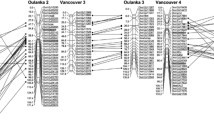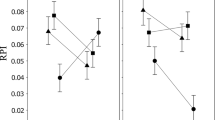Abstract
Sexually dimorphic traits are likely to have evolved through sexually antagonistic selection. However, recent empirical data suggest that intralocus sexual conflict often persists, even when traits have diverged between males and females. This implies that evolved dimorphism is often incomplete in resolving intralocus conflict, providing a mechanism for the maintenance of genetic variance in fitness-related traits. We used experimental evolution in Drosophila melanogaster to directly test for ongoing conflict over a suite of sexually dimorphic cuticular hydrocarbons (CHCs) that are likely targets of sex-specific selection. Using a set of experimental populations in which the transmission of genetic material had been restricted to males for 82 generations, we show that CHCs did not evolve, providing experimental evidence for the absence of current intralocus sexual conflict over these traits. The absence of ongoing conflict could indicate that CHCs have never been the target of sexually antagonistic selection, although this would require the existing dimorphism to have evolved via completely sex-linked mutations or as a result of former, but now absent, pleiotropic effects of the underlying loci on another trait under sexually antagonistic selection. An alternative interpretation, and which we believe to be more likely, is that the extensive CHC sexual dimorphism is the result of past intralocus sexual conflict that has been fully resolved, implying that these traits have evolved genetic independence between the sexes and that genetic variation in them is therefore maintained by alternative mechanisms. This latter interpretation is consistent with the known roles of CHCs in sexual communication in this species and with previous studies suggesting the genetic independence of CHCs between males and females. Nevertheless, direct estimates of sexually antagonistic selection will be important to fully resolve these alternatives.
Similar content being viewed by others
References
Abbott J. K., Bedhomme S. and Chippindale A. K. 2010 Sexual conflict in wing size and shape in Drosophila melanogaster. J. Evol. Biol. 23, 1989–1997.
Aitchison J. 1986 The statistical analysis of compositional data. Chapman and Hall, London, UK.
Bedhomme S. and Chippindale A. K. 2007 Irreconcilable differences: when sexual dimorphism fails to resolve sexual conflict. In Sex, size and gender roles (ed. D. J. Fairbairn, W. U. Blanckenhorn and T. Székely). pp. 185–194. Oxford University Press, New York, USA.
Bedhomme S., Prasad N. G., Jiang P. P. and Chippindale A. K. 2008 Reproductive behaviour evolves rapidly when intralocus sexual conflict is removed. PLoS ONE 3, e2187.
Benjamini Y. and Hochberg Y. 1995 Controlling the false discovery rate - a practical and powerful approach to multiple testing. J. R. Stat. Soc., B 57 289–300.
Bergerud W. A. 1996 Displaying factor relationships in experiments. Am. Stat. 50, 228–233.
Billeter J. C., Atallah J., Krupp J. J., Millar J. G. and Levine J. D. 2009 Specialized cells tag sexual and species identity in Drosophila melanogaster. Nature 461, 987–992.
Blows M. W. and Allan R. A. 1998 Levels of mate recognition within and between two Drosophila species and their hybrids. Am. Nat. 152, 826–837.
Bonduriansky R. and Chenoweth S. F. 2009 Intralocus sexual conflict. Trends Ecol. Evol. 24, 280–288.
Chenoweth S. F. and Blows M. W. 2003 Signal trait sexual dimorphism and mutual sexual selection in Drosophila serrata. Evolution 57, 2326–2334.
Chenoweth S. F. and Blows M. W. 2005 Contrasting mutual sexual selection on homologous signal traits in Drosophila serrata. Am. Nat. 165, 281–289.
Chenoweth S. F., Rundle H. D. and Blows M. W. 2008 Genetic constraints and the evolution of display trait sexual dimorphism by natural and sexual selection. Am. Nat. 171, 22–34.
Chenoweth S. F., Rundle H. D. and Blows M. W. 2010 Experimental evidence for the evolution of indirect genetic effects: changes in the interaction effect coefficient, Psi, due to sexual selection. Evolution 64, 1849–1856.
Chippindale A. K. and Rice W. R. 2001 Y chromosome polymorphism is a strong determinant of male fitness in Drosophila melanogaster. Proc. Natl. Acad. Sci. USA 98, 5677– 5682.
Cox R. M. and Calsbeek R. 2009 Sexually antagonistic selection, sexual dimorphism, and the resolution of intralocus sexual conflict. Am. Nat. 173, 176–187.
Coyne J. A., Crittenden A. P. and Mah K. 1994 Genetics of a pheromonal difference contributing to reproductive isolation in Drosophila. Science 265, 1461–1464.
Dallerac R., Labeur C., Jallon J. M., Knippie D. C., Roelofs W. L. and Wicker-Thomas C. 2000 A Delta 9 desaturase gene with a different substrate specificity is responsible for the cuticular diene hydrocarbon polymorphism in Drosophila melanogaster. Proc. Natl. Acad. Sci. USA 97, 9449–9454.
Everaerts C., Lacaille F. and Ferveur J. F. 2010 Is mate choice in Drosophila males guided by olfactory or gustatory pheromones? Anim. Behav. 79, 1135–1146.
Fang S., Takahashi A. and Wu C. I. 2002 A mutation in the promoter of desaturase 2 is correlated with sexual isolation between Drosophila behavioral races. Genetics 162, 781–784.
Ferveur J. F. 2005 Cuticular hydrocarbons: Their evolution and roles in Drosophila pheromonal communication. Behav. Genet. 35, 279–295.
Ferveur J. F. and Jallon J. M. 1993 Genetic control of pheromones in Drosophila simulans. 2. Kete, a locus on the X-chromosome. Genetics 133, 561–567.
Ferveur J. F. and Sureau G. 1996 Simultaneous influence on male courtship of stimulatory and inhibitory pheromones produced by live sex-mosaic Drosophila melanogaster. Proc. Natl. Acad. Sci. USA 263, 967–973.
Foley B., Chenoweth S. F., Nuzhdin S. V. and Blows M. W. 2007 Natural genetic variation in cuticular hydrocarbon expression in male and female Drosophila melanogaster. Genetics 175, 1465–1477.
Gibbs A. G.1998 Water-proofing properties of cuticular lipids. Am. Zool. 38, 471–482.
Gibbs A. G., Chippindale A. K. and Rose M. R. 1997 Physiological mechanisms of evolved desiccation resistance in Drosophila melanogaster. J. Exp. Biol. 200, 1821–1832.
Grillet M., Dartevelle L. and Ferveur J. F. 2006 A Drosophila male pheromone affects female sexual receptivity. Proc. R. Soc. London, Ser. B 273, 315–323.
Higgie M. and Blows M. W. 2008 The evolution of reproductive character displacement conflicts with how sexual selection operates within a species. Evolution 62, 1192–1203.
Higgie M., Chenoweth S. and Blows M. W. 2000 Natural selection and the reinforcement of mate recognition. Science 290, 519–521.
Howard R. W. and Blomquist G. J. 2005 Ecological, behavioral, andbiochemical aspects of insect hydrocarbons. Ann. Rev. Entomol. 50, 371–393.
Jiang P. P. , Bedhomme S., Prasad N. G. and Chippindale A. K. 2011 Sperm competition and mate harm unresponsive to male-limited selection in Drosophila: an evolving genetic architecture under domestication. Evolution 65, 2448–2460.
Kent C., Azanchi R., Smith B., Formosa A. and Levine J. D. 2008 Social context influences chemical communication in D. melanogaster males. Curr. Biol. 18, 1384–1389.
Kwan L. and Rundle H. D. 2010 Adaptation to desiccation fails to generate pre- and postmating isolation in replicate Drosophila melanogaster laboratory populations. Evolution 64, 710–723.
Long T. A. F. and Rice W. R. 2007 Adult locomotory activity mediates intralocus sexual conflict in a laboratory-adapted population of Drosophila melanogaster. Proc. R. Soc. London, Ser. B 274, 3105–3112.
Nelson D. R. 1993 Methyl-branched lipids in insects. In Chemistry, biochemistry and biology (ed. D. W. Stanley-Samuelson and D. R. Nelson). pp. 271–315. University of Nebraska Press, Lincoln, USA.
Newman J. A., Bergelson J. and Grafen A. 1997 Blocking factors and hypothesis tests in ecology: is your statistics text wrong? Ecology 78, 1312–1320.
Poissant J., Wilson A. J. and Coltman D. W. 2010 Sex-specific genetic variance and the evolution of sexual dimorphism: a systematic review of cross-sex genetic correlations. Evolution 64, 97–107.
Prasad N. G. , Bedhomme S., Day T. and Chippindale A. K. 2007 An evolutionary cost of separate genders revealed by male-limited evolution. Am. Nat. 169, 29–37.
Quinn G. P. and Keough M. J. 2002 Experimental design and data analysis for biologists. Cambridge University Press, New York, USA.
Rice W. R. 1996 Sexually antagonistic male adaptation triggered by experimental arrest of female evolution. Nature 381, 232–234.
Rice W. R. 1998 Male fitness increases when females are eliminated from gene pool: Implications for the Y chromosome. Proc. Natl. Acad. Sci. USA 95, 6217–6221.
Rouault J., Capy P. and Jallon J. M. 2000 Variations of male cuticular hydrocarbons with geoclimatic variables: an adaptative mechanism in Drosophila melanogaster? Genetica 110, 117–130.
Rundle H. D. and Chenoweth S. F. 2011 Stronger convex (stabilizing) selection on homologous sexual display traits in females than in males: a multipopulation comparison in Drosophila serrata. Evolution 65, 893–899.
Rundle H. D., Chenoweth S. F., Doughty P. and Blows M. W. 2005 Divergent selection and the evolution of signal traits and mating preferences. PLoS Biol. 3, e368.
Rybak F., Sureau G. and Aubin T. 2002 Functional coupling of acoustic and chemical signals in the courtship behaviour of the male Drosophila melanogaster. Proc. R. Soc. London, Ser. B 269, 695–701.
Savarit F. and Ferveur J. F. 2002 Genetic study of the production of sexually dimorphic cuticular hydrocarbons in relation with the sex-determination gene transformer in Drosophila melanogaster. Genet. Res. 79, 23–40.
Shirangi T. R., Dufour H. D., Williams T. M. and Carroll S. B. 2009 Rapid evolution of sex pheromone-producing enzyme expression in drosophila. PLoS Biol. 8, e1000168.
Svensson E. I., McAdam A. G. and Sinervo B. 2009 Intralocus sexual conflict over immune defense, gender load, and sex-specific signaling in a natural lizard population. Evolution 63, 3124–3135.
Toolson E. C. and Kupersimbron R. 1989 Laboratory evolution of epicuticular hydrocarbon composition and cuticular permeability in Drosophila pseudoobscura - effects on sexual dimorphism and thermal acclimation ability. Evolution 43, 468–473.
Van Homrigh A., Higgie M., McGuigan K. and Blows M. W. 2007 The depletion of genetic variance by sexual selection. Curr. Biol. 17, 528–532.
Wicker-Thomas C. and Jallon J. M. 2000 Role of Enhancer of zeste on the production of Drosophila melanogaster pheromonal hydrocarbons. Naturwissenschaften 87, 76–79.
Author information
Authors and Affiliations
Corresponding author
Additional information
[Bedhomme S., Chippindale A. K., Prasad N. G., Delcourt M., Abbott J. K., Mallet M. A. and Rundle H. D. 2011 Male-limited evolution suggests no extant intralocus sexual conflict over the sexually dimorphic cuticular hydrocarbons of Drosophila melanogaster. J. Genet. 90, xx-xx]
Rights and permissions
About this article
Cite this article
BEDHOMME, S., CHIPPINDALE, A.K., PRASAD, N.G. et al. Male-limited evolution suggests no extant intralocus sexual conflict over the sexually dimorphic cuticular hydrocarbons of Drosophila melanogaster . J Genet 90, 443–452 (2011). https://doi.org/10.1007/s12041-011-0109-3
Received:
Revised:
Accepted:
Published:
Issue Date:
DOI: https://doi.org/10.1007/s12041-011-0109-3




